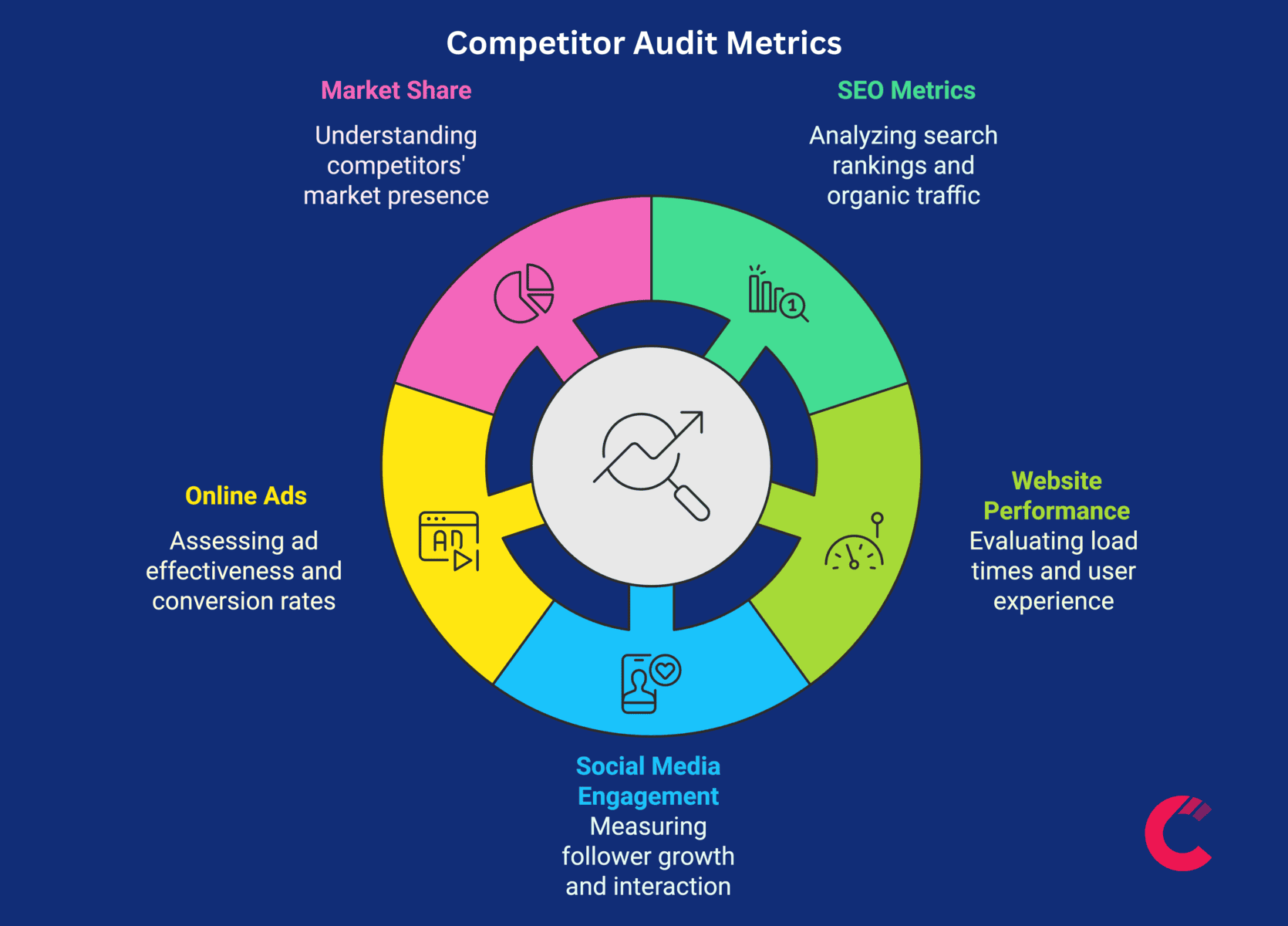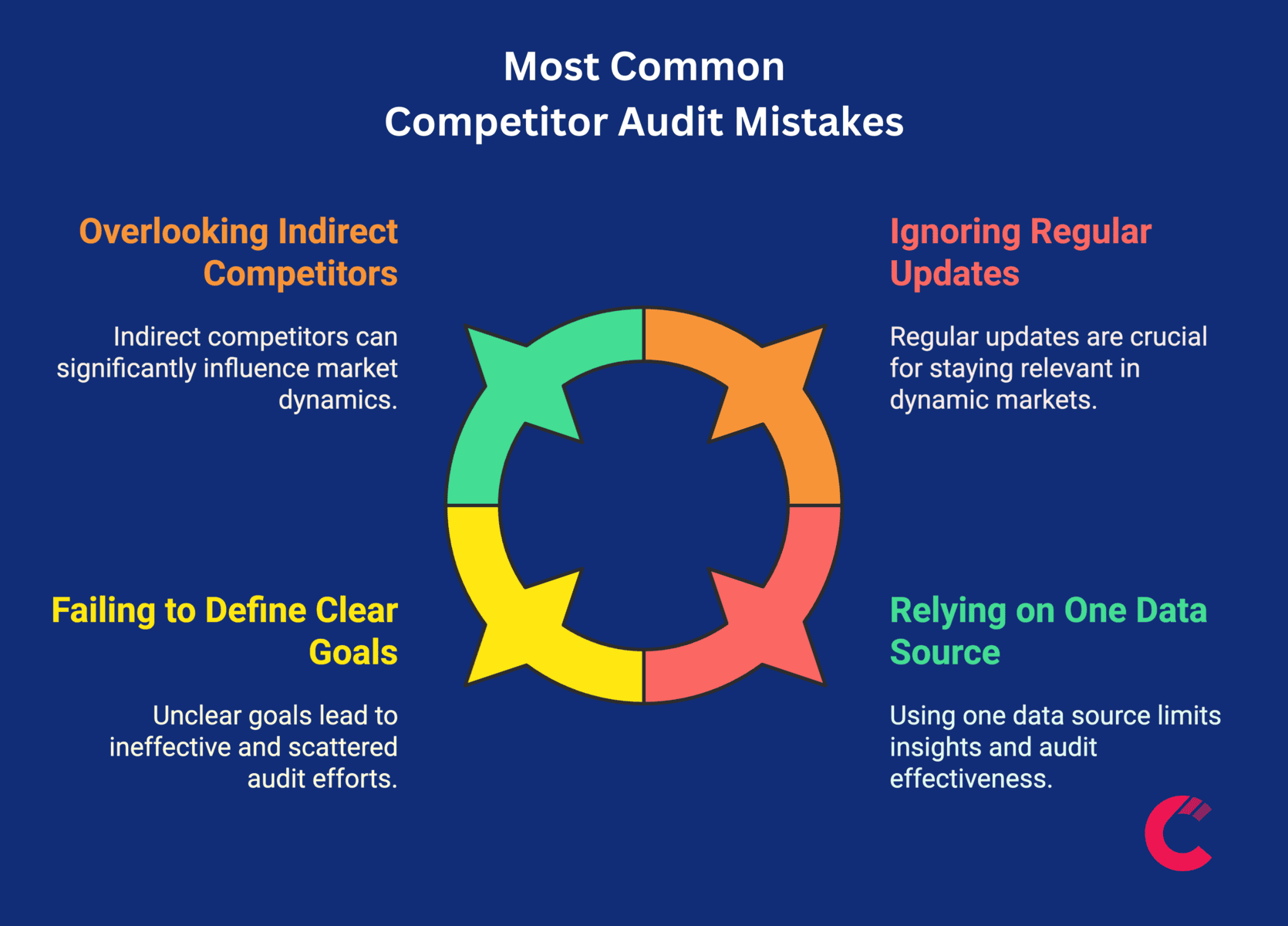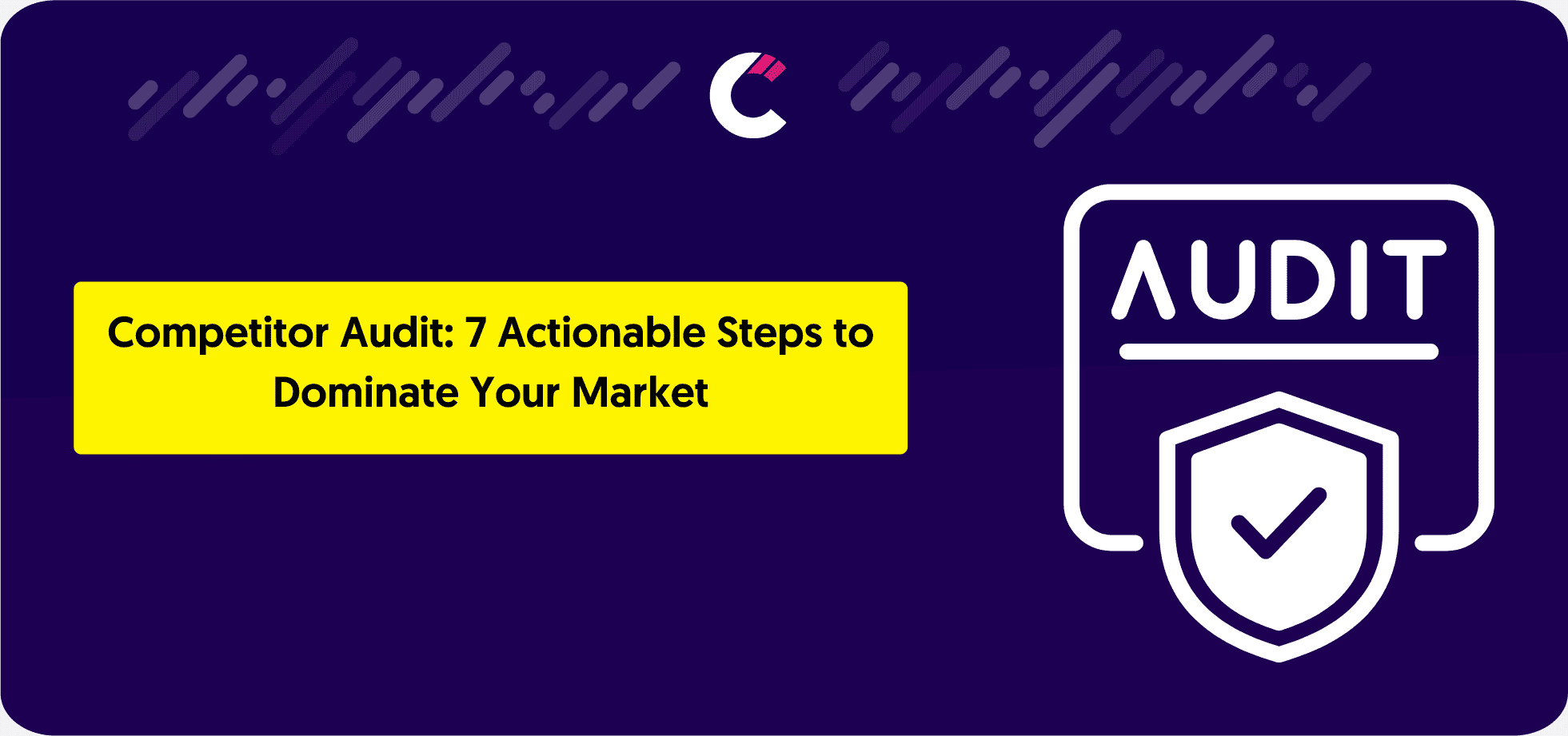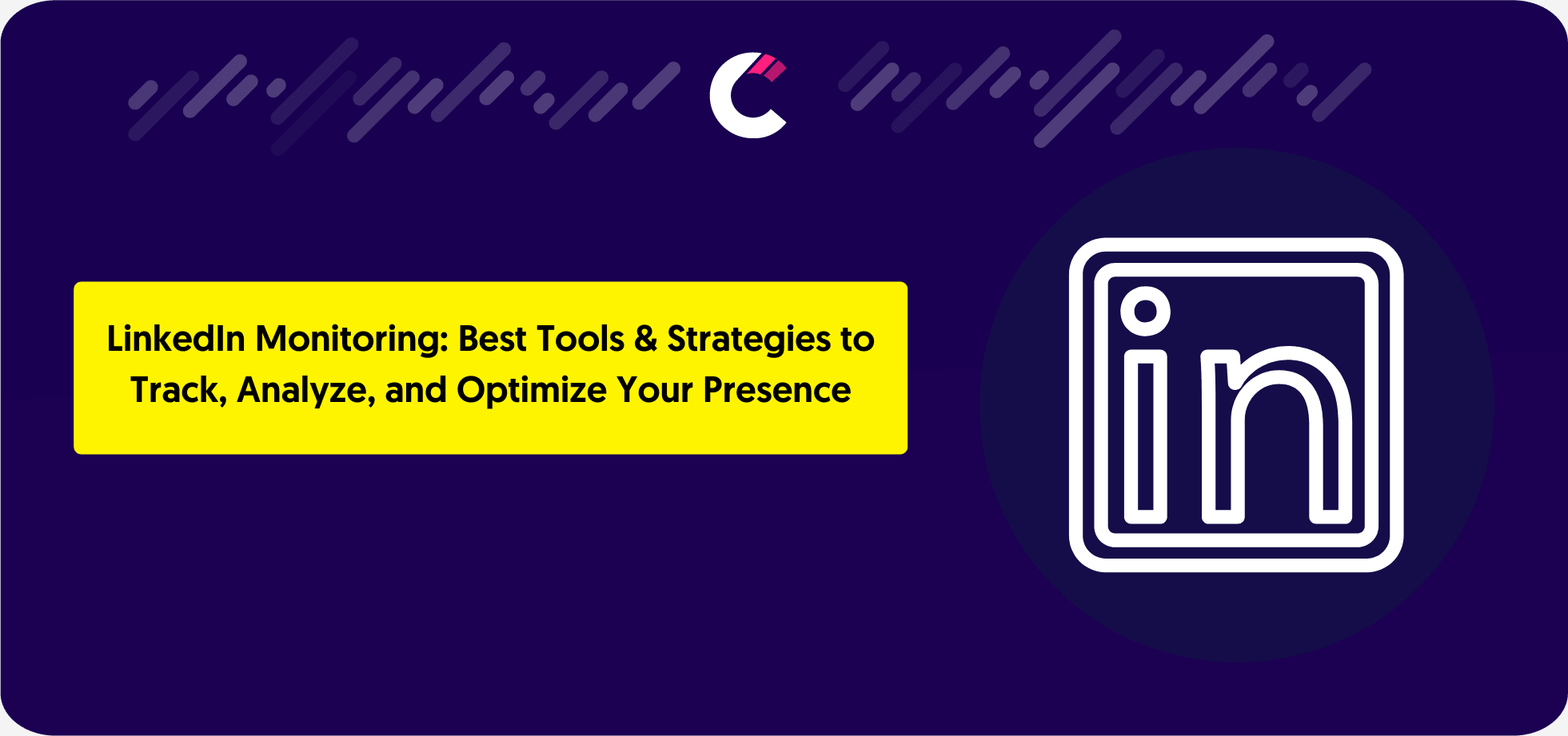What is a Competitor Audit?
A competitor audit is a structured process of analyzing your competitors to uncover insights that can fuel your business strategy. It helps you understand their strengths, weaknesses, and market positioning, allowing you to make informed decisions that drive growth.
This audit can take various forms:
- Competitor website audit: Analyze their website’s performance, user experience, and SEO metrics.
- Competitor social media audit: Study their engagement rates, follower growth, and campaign success.
- SEO competitor audit: Compare their search engine rankings, keywords, and content strategy.
- Competitor online ads analysis: Evaluate their ad campaigns, including spend, targeting strategies, and performance metrics.
Why does this matter? A competitor audit provides actionable data that can sharpen your marketing, refine your products, and uncover gaps in the market. By analyzing aspects like online ads, you can identify which strategies are working for your competitors and apply those insights to maximize your advertising ROI. It’s not just about gathering information—it’s about turning data into a strategic edge.
Why is a Competitor Audit Important?
Conducting a competitor audit is more than just a routine task—it’s a game-changing strategy for businesses aiming to thrive in competitive markets. By analyzing your competitors, you gain a deep understanding of what works in your industry and where there’s room for improvement. Here’s why it’s so essential:
- Improved Business Strategy: A competitor audit helps you identify trends, best practices, and potential gaps in the market. This information allows you to adjust your strategy to stay ahead.
- Better Decision-Making: Insights gained from audits, such as a marketing audit of your competitors, empower you to make data-driven decisions in marketing, product development, and pricing.
- Enhanced Market Positioning: Understanding how your competitors perform, from their online ads to their social media engagement, lets you position your brand more effectively.
- Innovation Opportunities: By identifying your competitors’ weaknesses, you can innovate where they fall short, capturing unmet customer needs.
The results of a competitor audit can also feed directly into actionable plans for your marketing and advertising campaigns, making your efforts more focused and impactful. It’s a critical tool to ensure that your business doesn’t just compete but leads.
7 Steps to Conducting a Competitor Audit
Step 1: Define the Purpose of Your Audit
Before diving into data, it’s essential to clarify why you’re conducting a competitor audit.
Are you looking to improve your marketing efforts, benchmark your performance, or identify new trends? Defining your goals ensures your audit stays focused and actionable.
For example:
- If your goal is to improve advertising, focus on analyzing competitors’ online ads.
- If you want to refine your digital presence, prioritize an SEO competitor audit or a competitor website audit.
By having clear objectives, you can tailor the audit to deliver insights that directly impact your business strategy.
Step 2: Identify Competitors
Start by categorizing your competitors into direct and indirect groups. Direct competitors target the same audience with similar products or services, while indirect competitors may fulfill the same need differently. For example, if you run a fitness app, a direct competitor could be another fitness app, while an indirect competitor might be a YouTube fitness channel.
Use these methods to find competitors:
- Search Related Keywords: A quick Google search for industry-specific terms can reveal key players.
- Competitor Tools: Platforms like Competitors App simplify tracking by automatically identifying and monitoring competitors’ activities.
Step 3: Gather Data on Competitors
Once you’ve identified competitors, collect data across key areas:
- Website performance: Check SEO rankings, page load times, and usability.
- Social media: Analyze their follower growth, engagement rates, and campaign results.
- Online ads: Study their ad spend, targeting, and messaging strategies.
- Product and pricing: Compare their offerings, pricing models, and customer reviews.
A holistic approach ensures you cover all bases, giving you a complete picture of your competitors.
Step 4: Use Tools to Conduct the Audit
Leverage specialized tools to streamline data collection and analysis:
- Competitors App: Automates tracking of website updates, social media activity, and ad campaigns.
- Semrush and Ahrefs: Focus on SEO competitor audits and keyword analysis.
- Crayon: Provides insights into competitors’ marketing strategies.
These tools save time and ensure accurate data, allowing you to focus on actionable insights.
Step 5: Perform SWOT Analysis
A SWOT analysis is a straightforward but powerful framework to evaluate your competitors. Here’s how to create one:
- Strengths: Identify what competitors excel at, such as strong SEO rankings, innovative products, or effective social media strategies.
- Weaknesses: Look for areas they struggle in, like slow website speeds or poor customer reviews.
- Opportunities: Find gaps in their strategy, such as untapped market segments or missing product features.
- Threats: Recognize external factors, like new market entrants or changes in industry regulations, that could impact your positioning.
Organizing this information into a matrix makes it easy to compare competitors side by side.
Step 6: Identify Opportunities and Create Action Items
Use the findings from your SWOT analysis to pinpoint actionable opportunities. For example:
- If competitors lack social media engagement, focus on building a stronger presence there.
- If their pricing is higher, position your brand as a more affordable alternative.
Once you’ve identified these opportunities, create a list of specific action items to address them. This ensures your audit leads to measurable results.
Step 7: Monitor and Update Regularly
A competitor audit isn’t a one-time task. Markets evolve, and so do your competitors’ strategies. Regularly revisit and update your audit to stay informed. Set a schedule, such as quarterly reviews, and use tools like Competitors App to automate the process.
Frequent updates ensure you’re always equipped with the latest insights to refine your strategy.
Key Metrics and Insights to Focus On

Focusing on the right metrics during a competitor audit ensures you derive actionable insights. Here are key areas to analyze:
SEO Metrics
- Search engine rankings for target keywords.
- Organic traffic volume and growth trends.
- Backlink profiles and domain authority.
Website Performance
- Page load times and mobile responsiveness.
- Content quality, structure, and call-to-action elements.
- Navigation and overall user experience.
Social Media Engagement
- Follower growth rates and audience demographics.
- Engagement metrics like likes, shares, and comments.
- Campaign effectiveness and hashtag strategies.
Online Ads
- Ad formats, messaging, and targeting strategies.
- Estimated ad spend and reach across platforms.
- Conversion rates from ads to sales or leads.
Market Share and Share of Voice
- How much attention competitors command in the market.
- Their visibility across various channels compared to yours.
By tracking these metrics, you gain a comprehensive understanding of competitors’ performance and can benchmark your efforts effectively.
Common Mistakes in Competitor Audits

While conducting a competitor audit can be a game-changer, avoiding common pitfalls is crucial to ensure its effectiveness. Here are the key mistakes to watch out for:
Overlooking Indirect Competitors
Many audits focus solely on direct competitors, ignoring indirect ones who may fulfill the same customer needs differently. This oversight can lead to missed opportunities.Failing to Define Clear Goals
Without specific objectives, audits can become unfocused, making it harder to derive actionable insights. Clearly define whether your aim is to improve SEO, refine pricing, or analyze online ads.Ignoring Regular Updates
Competitor audits should be a continuous process, not a one-off task. Neglecting updates means you might miss new trends or strategic shifts in your industry.Relying Only on One Data Source
Depending on a single tool or platform can limit the scope of your audit. Combining multiple tools like Competitors App, Semrush, and social media analytics platforms ensures comprehensive coverage.
By addressing these mistakes, you can enhance the reliability and impact of your competitor audit.
Best Times to Conduct a Competitor Audit
Timing plays a crucial role in the effectiveness of a competitor audit. Conducting audits at the right moments ensures you gather insights when they’re most impactful. Here are the best times to initiate a competitor audit:
Before Launching a New Product or Campaign
Analyzing competitors helps you identify gaps in their offerings or marketing strategies, allowing you to position your product effectively and stand out.When Entering a New Market
Understanding the competitive landscape of a new market ensures you adapt your approach to local preferences, pricing norms, and customer expectations.During Major Industry Shifts
If there’s a significant change in consumer behavior, regulations, or technology, a competitor audit can reveal how others are adapting and help you stay ahead.To Benchmark Performance Annually
Regularly auditing competitors provides a clear benchmark for your progress over time, helping you refine long-term strategies.
Conducting audits during these pivotal moments enables your business to stay proactive rather than reactive, ensuring you make decisions grounded in real-time data.
Frequently Asked Questions (FAQs)
What is a competitor audit?
A competitor audit is a systematic process of analyzing your competitors' strategies, performance, and market position to identify opportunities and improve your business approach.
How do you classify competitors?
Competitors can be classified as direct (offering similar products or services to the same target audience) or indirect (offering alternative solutions that fulfill the same customer need).
What are the steps in conducting a competitor audit?
Key steps include defining your audit goals, identifying competitors, gathering data, performing analysis (e.g., SWOT), and creating actionable strategies.
What is an SEO competitor audit?
An SEO competitor audit evaluates the search engine optimization strategies of your competitors, such as keyword rankings, backlink profiles, and overall website performance, to identify areas where your site can improve.
What is a social media competitor audit?
A social media competitor audit analyzes your competitors' social media presence, including follower growth, engagement rates, content strategies, and campaign effectiveness, to refine your social media marketing efforts.
What is a website competitor audit?
A website competitor audit assesses competitors' websites, focusing on factors like user experience, site speed, content quality, and design, to help improve your own website's performance.
How do you use competitor audit data?
Competitor audit data can be used to refine marketing strategies, identify market gaps, enhance product offerings, and develop competitive advantages.






